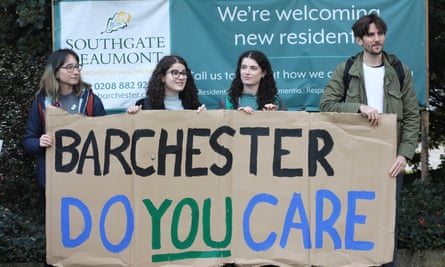Campaigners have demanded higher pay for social care workers in the capital, as new analysis put the outer London borough of Haringey at the top of the UK league for jobs paying below the real living wage.
As inflation hit its highest level for 41 years, protesters from the community campaign group Citizens UK gathered outside a Haringey care home, run by the private chain Barchester Healthcare, to call for a real living wage for care staff.
More than a third of jobs based in the borough, 34.2%, earn less than the real living wage. It is the highest rate for any local authority across the UK, according to new analysis by the Living Wage Foundation.
Haringey was closely followed by other outer London boroughs, including Bexley (33.1%), Redbridge (31.9%) and Walthamstow (30.4%).
The real living wage is calculated by the independent Living Wage Foundation each year, based on the costs of the basics necessary for a decent standard of living. In 2021-22, it was £9.90 across the UK, and £11.05 in London.
Outer London boroughs are judged according to the higher rate, because the cost of living locally is high – but they tend not to have as many of the higher-paid jobs more prevalent in inner London.
Analysis of official data shows that last year was the first since 2012 when a higher proportion of workers across London (13.6%) were earning less than the real living wage than across the UK as a whole (12.2%). Both these figures were lower than a year earlier, however, as the statutory “national living wage” was increased.
The national living wage is determined by the government and paid to workers aged 23 and above. It was set at £9.50 this year, close to the UK-wide real living wage, but £1.15 below the London rate.
The chancellor, Jeremy Hunt, is expected to announce a significant increase in this national living wage in Thursday’s financial statement, given the high rate of inflation – perhaps taking it to £10.40 an hour.
The Living Wage Foundation has recommended that accredited employers who have promised to pay the real living wage – which includes half the FTSE100 – increase pay to £10.90 an hour across the UK, and £11.95 for London, in the coming year.
Citizens UK, which started in east London more than 20 years ago, involves churches, schools and community groups in its campaigns.
Local teacher Dominique Edwards, of Haringey Learning Partnership, who attended the protest with two of her pupils, said: “All of our students come from the borough. We are finding even parents who have full-time jobs are still struggling to meet some of their basic needs.
“At the end of the day, if their families are struggling, ultimately it has a direct impact on the young people.”
With no one from the home willing to talk to the small group of protesters, they delivered cards to the care workers from pupils at the local Willow primary school through the letterbox.
Paul Amuzie, of Citizens UK Haringey, said: “We are a membership organisation, and the issues we work on have come from their stories – and ultimately, low pay means kids coming into school with no breakfast.”
after newsletter promotion

Barchester Healthcare is currently advertising for care assistants to work at the Haringey home on a wage of “up to £10 an hour”. The company hit the headlines in 2020 when its chief executive, Pete Calveley, earned more than £2m.
Barchester’s latest accounts show that it made a £2.57m loss in 2021. Its highest-paid director – likely to be Calveley – took home £898,000.
The filing with Companies House notes that this did not constitute this individual’s entire earnings, however, as the directors were also “employed by another company within the Grove Ltd group”. Grove Ltd is Barchester’s Jersey-based ultimate owner.
Social care is one of the sectors being hit hardest by the staff shortages currently plaguing the UK economy.
Research by the King’s Fund thinktank earlier this year found that half of care workers in independent care homes would earn more in an entry-level job at a supermarket.
A spokesperson for Barchester Healthcare said: “We take the wellbeing of our employees very seriously and offer the most comprehensive remuneration package in the care sector. We actively benchmark ourselves against other providers to ensure we are in the upper quartile on remuneration for care home staff.” They added that all staff at the home were paid “at least £9.90 an hour”.
